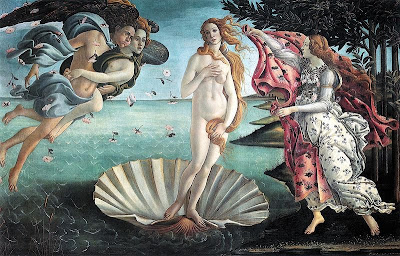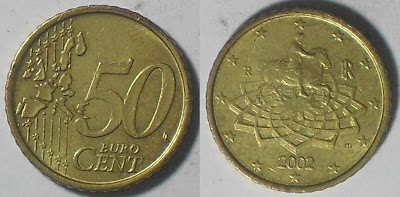10 cent, 2007
 The picture shown on this coin is from Alessandro Botticelli’s “Birth of Venus” (1485). In the painting, the goddess Venus [or Aphrodite as she is known in Greek mythology] emerges from the sea upon a shell in accordance with the myth that explains her birth. Her shell is pushed to the shore from the winds produced by the Zephyr wind-gods amid a shower of roses. As the goddess is about to step on the shore, one of the Nymphs reaches out to cover her with a purple cloak. This painting is among the most treasured masterpieces of the Renaissance.
The picture shown on this coin is from Alessandro Botticelli’s “Birth of Venus” (1485). In the painting, the goddess Venus [or Aphrodite as she is known in Greek mythology] emerges from the sea upon a shell in accordance with the myth that explains her birth. Her shell is pushed to the shore from the winds produced by the Zephyr wind-gods amid a shower of roses. As the goddess is about to step on the shore, one of the Nymphs reaches out to cover her with a purple cloak. This painting is among the most treasured masterpieces of the Renaissance."Birth of venus" by Sandro Botticelli

"Unique forms of continuity in space" by Umberto Berlusconi
 The Italy 20 cent coin depicts a bronze sculpture made by Umberto Berlusconi, which is titled "Unique Forms of Continuity in Space". It is seen as an expression of movement and fluidity. Boccioni rejected traditional sculpture and depictions to create this piece and it is seen as a masterpiece of Futurism.
The Italy 20 cent coin depicts a bronze sculpture made by Umberto Berlusconi, which is titled "Unique Forms of Continuity in Space". It is seen as an expression of movement and fluidity. Boccioni rejected traditional sculpture and depictions to create this piece and it is seen as a masterpiece of Futurism.Unique Forms of Continuity in Space depicts a human-like figure seemingly flying or gliding through air. A clinging drapery whips back around his legs, giving the sculpture an aerodynamic and fluid form. Instead of a traditional pedestal, the figure is only bound to the ground by two blocks at his feet. The figure is also armless and without a discernibly real face.
50 cent, 2002
 This coin shows the figure of the Roman emperor Marcus Aurelius on horseback. Marcus Aurelius Antoninus was Roman Emperor from 161 to 180. He ruled with Lucius Verus as co-emperor from 161 until Verus' death in 169. He was the last of the "Five Good Emperors", and is also considered one of the most important Stoic philosophers. Stoicism was a school of Hellenistic philosophy founded in Athens by Zeno of Citium in the early 3rd century BC. The Stoics considered destructive emotions to be the result of errors in judgment, and that a sage, or person of "moral and intellectual perfection," would not suffer such emotions.
This coin shows the figure of the Roman emperor Marcus Aurelius on horseback. Marcus Aurelius Antoninus was Roman Emperor from 161 to 180. He ruled with Lucius Verus as co-emperor from 161 until Verus' death in 169. He was the last of the "Five Good Emperors", and is also considered one of the most important Stoic philosophers. Stoicism was a school of Hellenistic philosophy founded in Athens by Zeno of Citium in the early 3rd century BC. The Stoics considered destructive emotions to be the result of errors in judgment, and that a sage, or person of "moral and intellectual perfection," would not suffer such emotions.During his reign, the empire defeated a revitalized Parthian Empire; Aurelius' general Avidius Cassius sacked the capital Ctesiphon in 164. Aurelius fought the Marcomanni, Quadi, and Sarmatians with success during the Marcomannic Wars, but the threat of the Germanic Tribes began to represent a troubling reality for the empire. A revolt in the east led by Avidius Cassius failed to gain momentum and was suppressed immediately.
Marcus Aurelius' work Meditations, written in Greek while on campaign between 170 and 180, is still revered as a literary monument to a government of service and duty. It serves as an example of how Aurelius approached the Platonic ideal of a philosopher-king and how he symbolized much of what was best about Roman civilization.


No comments:
Post a Comment